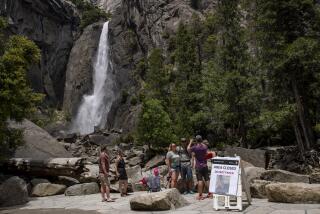Yosemite Rock Slide Pounds Locals
- Share via
YOSEMITE NATIONAL PARK — Primitivo Garcia’s commute to the hotel restaurant he manages at Yosemite National Park’s western edge was a scenic 20-minute drive through the narrow, winding canyon of the Merced River.
That was before a massive slide covered California 140, a main route into Yosemite, with 3 million cubic yards of rocks and dirt.
Now, the journey from Garcia’s home in the town of Midpines to Cedar Lodge takes him nearly 100 miles through a different gate and into Yosemite Valley, then back down Highway 140 to El Portal -- a round trip of five to six hours on tortuous mountain roads and through the traffic-choked park.
“I’m going to do this until my car dies,” says Garcia, who estimates he’s spending almost $200 a week to get to work. The cheapest gas in El Portal, near a park entrance, was selling for $4.02 a gallon.
The still-active rock slide hasn’t thinned the throngs of visitors to the park.
But the blockage is hurting businesses in and around the park that have been distanced from their employees and supply chain.
The road closure is devastating to towns such as Mariposa, which lies outside Yosemite and relies on park visitors for its livelihood.
It’s now a four-hour round trip to the park by alternate routes.
Park employee Lloyd Sheetz and his wife, Linda Niles-Sheetz, live in Mariposa. They work in El Portal, on the other side of the slide, where their two daughters also attend elementary school.
They wake up the girls at 5 a.m. for a day that includes five hours of driving, adding about 1,000 miles a week to their car’s mileage.
“We’re just exhausted,” Niles-Sheetz said. “The cost is incredible.... I don’t know what we can take.”
State transportation officials told El Portal residents last week that one relief option might be to build two temporary bridges over the Merced River to divert traffic around the 300 feet of debris that still covers Highway 140.
Geologists are studying the crumbling hillside, trying to determine what made it start moving.
Heavy rainfall in April may be to blame, but for now the slide remains too active to install monitoring equipment, making it difficult to reach any conclusions.
“This is a prehistoric slide,” said Debbie Santiago, spokeswoman for the team of 12 federal, state and local agencies working on the slide.
As she spoke, rocks continued to tumble down the slope. The shower appears to be slowing down, but relief doesn’t seem possible any time soon, she said.
“Rocks as big as Volkswagens are coming down whenever they want to,” Santiago said. “It’s frustrating for us, and for the communities around here, but this could last another hour, it could last months or years. It’s not good, but it’s the truth.”
Tourists don’t seem to mind the hassle.
Highway 140, which normally carries about a third of park visitors, has been closed since April 29.
But park statistics show nearly 18% more visitors in May than during the same month last year.
Thomas Lyman, who recently drove from Los Angeles to spend two nights in the park, said taking the southern route along California 41 took half an hour longer but seeing Yosemite’s raging waterfalls in all their glory made it well worth the drive.
Officials in Mariposa County, which includes Yosemite Valley and Highway 140 as it climbs through the foothills and into the Sierra Nevada, estimate businesses there have lost about $4 million in tourism revenue.
If the blockage lasts through the summer, which appears likely, the losses could reach $14.5 million.
“Many of these businesses make maybe half their annual income in these summer months,” said Mike Coffield, the county’s administrative officer. “It’s just devastating.”
The slide also affects about 400 park and concessions workers and their families who live beyond the slide.
Children are falling asleep in cars and buses during the hours-long trip to school, parents are driving long hours just to buy groceries, and everyone is cutting expenses to pay for gas.
Adrienne Freeman, a park spokeswoman, lives in Midpines. The four- to five-hour commute is exhausting, but this is the risk of living so close to untamed wilderness, she said.
“It’s tiring, but I’m fortunate to work here,” she said, gesturing toward the thundering Bridalveil Fall, which was spraying tourists 100 yards away. “I’m not in control of the environment here. I enjoy that.”
Park officials say they’re doing what they can to help employees affected by the slide, including opening vacant housing to those who need a place to stay during the week and allowing others to use a trailer park that was being phased out, said Ranger Scott Gediman.
Delaware North Cos., which manages restaurants and lodging in the park, is running a shuttle service for workers that starts before dawn and ends after midnight.
Maintaining a stable workforce is essential at the start of the park’s busiest season, Gediman said.
But business owners such as Douglas Shaw, who owns the Yosemite Bug, a cluster of cabins and a hostel normally within 40 minutes of the park, don’t know how long they can hang on.
His business has dropped off 60% since the slide.
In one month he lost $50,000 and had to lay off a third of his employees.
He put up a house for sale to generate money but has had no takers because no one is driving the highway and other locals are strapped for cash.
“I’m very afraid,” he said.
“If this keeps on for a year, I don’t know what will happen to us.”
More to Read
Sign up for The Wild
We’ll help you find the best places to hike, bike and run, as well as the perfect silent spots for meditation and yoga.
You may occasionally receive promotional content from the Los Angeles Times.






